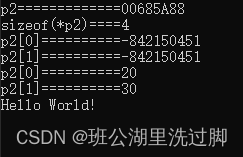new文件是动态内存管理库的一部分,特别提供低层内存管理特性。 它包括bad_alloc, bad_array_new_length,nothrow_t,align_val_t类nothrow常量,以及函数 operator newoperator new[],operator deleteoperator delete[],get_new_handler,set_new_handle等,
下面介绍它们的基本使用。
1.new与delete
new是动态分析内存,delete是释放分配的内存,它们是成对使用的。
代码示例:
#include <iostream>
#include <new>
using namespace std;
class Person {
public:
Person(string name, int age) :
m_name(name),
m_age(age) { }
private:
string m_name;
int m_age;
};
int main()
{
Person *p = new Person("camel", 28);
cout << "p==============" << p << endl;
cout << "sizeof(*p)=====" << sizeof(*p) << endl;//debug 版32个字节 release版28个字节
delete p;
cout << "Hello World!" << endl;
return 0;
}运行结果:

2.new[]和delete[]
new[]为数组分配内存但没有初始化,释放时使用delete[],它们是成对使用。
示例代码:
int main()
{
int *p2 = new int[2];
cout << "p2=============" << p2 << endl;
cout << "sizeof(*p2)====" << sizeof(*p2) << endl;
cout << "p2[0]==========" << p2[0] << endl;
cout << "p2[1]==========" << p2[1] << endl;
p2[0] = 20;
p2[1] = 30;
cout << "p2[0]==========" << p2[0] << endl;
cout << "p2[1]==========" << p2[1] << endl;
delete[] p2;
cout << "Hello World!" << endl;
return 0;
}
运行结果:

3.bad_alloc
bad_alloc 是分配函数作为异常抛出的对象类型,以报告存储分配失败。
int main()
{
try {
while (true) {
new int[100000000ul]; // 抛出重载
}
} catch (const std::bad_alloc& e) {
cout << "exception info:" << e.what() << endl;
}
cout << "Hello World!" << endl;
return 0;
}
运行结果:

4.nothrow
nothrow是std::nothrow_t类型的常量,当内存分析失败时不抛出异常,这个时候返回为nullptr。
示例代码:
int main()
{
while (true) {
int* p = new(std::nothrow) int[100000000ul]; // 不抛出重载
if (p == nullptr) {
cout << "Allocation returned ========================= nullptr" << endl;
break;
}
}
cout << "Hello World!" << endl;
return 0;
}
运行结果:

5.bad_array_new_length
bad_array_new_length是new表达式出现异常时报告非法数组长度的对象类型。有下在三种情况会抛出异常:
1) 数组长度为负
2) 新数组的总大小将超过实现定义最大值
3) 初始化器子句的数量超出要初始化的元素数量
仅数组第一维可生成此异常;第一维外的维数是常量表达式,在编译时得到检查。
示例代码:
int main()
{
int negative = -1;
int small = 1;
int large = INT_MAX;
try {
new int[negative]; // 负大小: bad_array_new_length
new int[small]{1,2,3}; // 过多初始化器: bad_array_new_length
new int[large][1000000]; // 过大: bad_alloc 或 bad_array_new_length
} catch(const std::bad_array_new_length &e) {
cout << "exception info:" << e.what() << '\n';
} catch(const std::bad_alloc &e) {
cout << "exception info:" << e.what() << '\n';
}
cout << "Hello World!" << endl;
return 0;
}
运行结果:

参考:






















 331
331











 被折叠的 条评论
为什么被折叠?
被折叠的 条评论
为什么被折叠?








